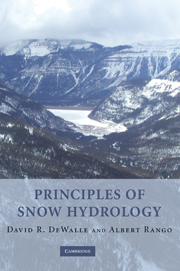Book contents
- Frontmatter
- Contents
- Preface
- 1 Introduction
- 2 Snow climatology and snow distribution
- 3 Snowpack condition
- 4 Ground-based snowfall and snowpack measurements
- 5 Remote sensing of the snowpack
- 6 Snowpack energy exchange: basic theory
- 7 Snowpack energy exchange: topographic and forest effects
- 8 Snowfall, snowpack, and meltwater chemistry
- 9 Snowmelt-runoff processes
- 10 Modelling snowmelt runoff
- 11 Snowmelt-Runoff Model (SRM)
- 12 Snowpack management and modifications
- Appendix A Physical constants
- Appendix B Potential solar irradiation theory
- Index
- Plate Section
- References
1 - Introduction
Published online by Cambridge University Press: 18 August 2009
- Frontmatter
- Contents
- Preface
- 1 Introduction
- 2 Snow climatology and snow distribution
- 3 Snowpack condition
- 4 Ground-based snowfall and snowpack measurements
- 5 Remote sensing of the snowpack
- 6 Snowpack energy exchange: basic theory
- 7 Snowpack energy exchange: topographic and forest effects
- 8 Snowfall, snowpack, and meltwater chemistry
- 9 Snowmelt-runoff processes
- 10 Modelling snowmelt runoff
- 11 Snowmelt-Runoff Model (SRM)
- 12 Snowpack management and modifications
- Appendix A Physical constants
- Appendix B Potential solar irradiation theory
- Index
- Plate Section
- References
Summary
Perceptions of snow
There is a general lack of appreciation by society of the importance of snow to everyday life. One good example of this is found in the Rio Grande Basin in the southwestern United States and Mexico. The Rio Grande, the third longest river in the United States, is sustained by snow accumulation and melt in the mountain rim regions which provide a major contribution to the total streamflow, despite its flowing right through the heart of North America's largest desert (Chihuahuan). Because the majority of the population in the basin resides in a few large cities in the Rio Grande Valley, which are all located in the desert (see Figure 1.1), there is little realization on the part of the urban residents that snowmelt far to the north is an important factor in their lives. This same situation is true in many arid mountainous regions around the globe. Where agricultural water use predominates, however, the importance of snow for the water supply and food production is more widely known, at least by farmers and ranchers and the rural populace.
The importance of snow during and in the aftermath of a snowstorm is immediately evident because of its significant effect on transportation (see Figure 1.2). The effects of snowstorms on wagon trains (in the past), railroads, and motorized transport are widely documented by Mergen (1997). Except for very small countries, the effect of a snowstorm on transportation is localized and does not affect the entire country.
- Type
- Chapter
- Information
- Principles of Snow Hydrology , pp. 1 - 19Publisher: Cambridge University PressPrint publication year: 2008
References
- 1
- Cited by



